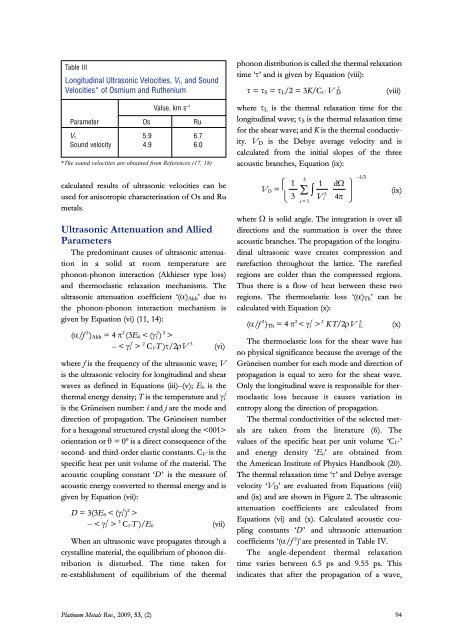Ultrasonic Study of Osmium and Ruthenium - Platinum Metals Review
Ultrasonic Study of Osmium and Ruthenium - Platinum Metals Review
Ultrasonic Study of Osmium and Ruthenium - Platinum Metals Review
Create successful ePaper yourself
Turn your PDF publications into a flip-book with our unique Google optimized e-Paper software.
Table III<br />
Longitudinal <strong>Ultrasonic</strong> Velocities, V 1, <strong>and</strong> Sound<br />
Velocities* <strong>of</strong> <strong>Osmium</strong> <strong>and</strong> <strong>Ruthenium</strong><br />
Value, km s –1<br />
Parameter Os Ru<br />
V 1 5.9 6.7<br />
Sound velocity 4.9 6.0<br />
*The sound velocities are obtained from References (17, 18)<br />
calculated results <strong>of</strong> ultrasonic velocities can be<br />
used for anisotropic characterisation <strong>of</strong> Os <strong>and</strong> Ru<br />
metals.<br />
<strong>Ultrasonic</strong> Attenuation <strong>and</strong> Allied<br />
Parameters<br />
The predominant causes <strong>of</strong> ultrasonic attenuation<br />
in a solid at room temperature are<br />
phonon-phonon interaction (Akhieser type loss)<br />
<strong>and</strong> thermoelastic relaxation mechanisms. The<br />
ultrasonic attenuation coefficient ‘(α) Akh ’ due to<br />
the phonon-phonon interaction mechanism is<br />
given by Equation (vi) (11, 14):<br />
(α/f 2 ) Akh = 4 π 2 (3E 0 <br />
– 2 C VT )τ/2ρV 3 (vi)<br />
where f is the frequency <strong>of</strong> the ultrasonic wave; V<br />
is the ultrasonic velocity for longitudinal <strong>and</strong> shear<br />
waves as defined in Equations (iii)–(v); E 0 is the<br />
thermal energy density; T is the temperature <strong>and</strong> γ i<br />
j<br />
is the Grüneisen number: i <strong>and</strong> j are the mode <strong>and</strong><br />
direction <strong>of</strong> propagation. The Grüneisen number<br />
for a hexagonal structured crystal along the <br />
orientation or θ = 0º is a direct consequence <strong>of</strong> the<br />
second- <strong>and</strong> third-order elastic constants. C V is the<br />
specific heat per unit volume <strong>of</strong> the material. The<br />
acoustic coupling constant ‘D’ is the measure <strong>of</strong><br />
acoustic energy converted to thermal energy <strong>and</strong> is<br />
given by Equation (vii):<br />
D = 3(3E 0 <br />
– < γ i<br />
j<br />
> 2 C VT )/E 0 (vii)<br />
When an ultrasonic wave propagates through a<br />
crystalline material, the equilibrium <strong>of</strong> phonon distribution<br />
is disturbed. The time taken for<br />
re-establishment <strong>of</strong> equilibrium <strong>of</strong> the thermal<br />
phonon distribution is called the thermal relaxation<br />
time ‘τ’ <strong>and</strong> is given by Equation (viii):<br />
τ = τ S = τ L /2 = 3K/C V V D<br />
2<br />
(viii)<br />
where τ L is the thermal relaxation time for the<br />
longitudinal wave; τ S is the thermal relaxation time<br />
for the shear wave; <strong>and</strong> K is the thermal conductivity.<br />
V D is the Debye average velocity <strong>and</strong> is<br />
calculated from the initial slopes <strong>of</strong> the three<br />
acoustic branches, Equation (ix):<br />
V D =<br />
⎧<br />
⎩<br />
1<br />
3<br />
3<br />
Σ ∫<br />
i =1<br />
1 dΩ<br />
V i<br />
3<br />
where Ω is solid angle. The integration is over all<br />
directions <strong>and</strong> the summation is over the three<br />
acoustic branches. The propagation <strong>of</strong> the longitudinal<br />
ultrasonic wave creates compression <strong>and</strong><br />
rarefaction throughout the lattice. The rarefied<br />
regions are colder than the compressed regions.<br />
Thus there is a flow <strong>of</strong> heat between these two<br />
regions. The thermoelastic loss ‘(α) Th ’ can be<br />
calculated with Equation (x):<br />
(α/f 2 ) Th = 4 π 2 j<br />
< γ i > 2 5<br />
KT/2ρV L (x)<br />
4π<br />
–1/3<br />
⎫<br />
⎭<br />
(ix)<br />
The thermoelastic loss for the shear wave has<br />
no physical significance because the average <strong>of</strong> the<br />
Grüneisen number for each mode <strong>and</strong> direction <strong>of</strong><br />
propagation is equal to zero for the shear wave.<br />
Only the longitudinal wave is responsible for thermoelastic<br />
loss because it causes variation in<br />
entropy along the direction <strong>of</strong> propagation.<br />
The thermal conductivities <strong>of</strong> the selected metals<br />
are taken from the literature (6). The<br />
values <strong>of</strong> the specific heat per unit volume ‘C V ’<br />
<strong>and</strong> energy density ‘E 0’ are obtained from<br />
the American Institute <strong>of</strong> Physics H<strong>and</strong>book (20).<br />
The thermal relaxation time ‘τ’ <strong>and</strong> Debye average<br />
velocity ‘V D ’ are evaluated from Equations (viii)<br />
<strong>and</strong> (ix) <strong>and</strong> are shown in Figure 2. The ultrasonic<br />
attenuation coefficients are calculated from<br />
Equations (vi) <strong>and</strong> (x). Calculated acoustic coupling<br />
constants ‘D’ <strong>and</strong> ultrasonic attenuation<br />
coefficients ‘(α/f 2 )’ are presented in Table IV.<br />
The angle-dependent thermal relaxation<br />
time varies between 6.5 ps <strong>and</strong> 9.55 ps. This<br />
indicates that after the propagation <strong>of</strong> a wave,<br />
<strong>Platinum</strong> <strong>Metals</strong> Rev., 2009, 53, (2) 94
















